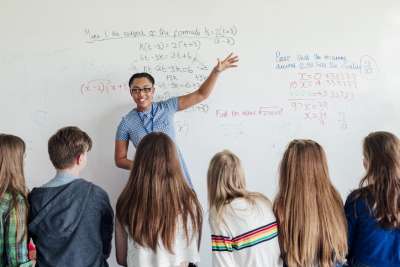How Can You Stretch Students' Thinking?
For students to internalize accurately what plane and solid figures are, they need to be shown examples as well as non-examples of the figures. Understanding what a triangle is and is not, a student can then identify triangles in different orientations, whether they are represented "sitting" on a side, balanced on a "point" or vertex, or rotated to be positioned somewhere in between. As students understand the essential attributes of figures, they can begin to understand relationships among figures: a square is a special kind of rectangle and a special kind of rhombus; and each of these-square, rectangle, and rhombus-is a quadrilateral.
When can you use it?
Reading/English
For primary grades, identify geometric shapes in picture books. Have students point out which objects and animals are drawn using simple geometric shapes, and identify shapes the artist uses to illustrate the story. Find examples of objects that are composite figures (made up of two or more different shapes) and list all the shapes used in each figure.
For intermediate grades, discuss shapes with students. Discuss how the shape of books makes them easy to stack, line up on shelves, and pack into boxes. Have students propose other shapes for books and brainstorm how library equipment such as shelves, carts, copy machines, and book-drop boxes might have to be designed differently to accommodate these differently shaped books.
Writing
For primary grades, have students describe plane figures such as circles, squares, and triangles. Encourage them to draw examples and non-examples of each. Students can create riddles and have other students guess the object that is described.
For intermediate grades, have students keep geometry journals in which they define concepts, such as parallel, quadrilateral, and slide image, as they study them.
Math
Geometry can be used throughout mathematics lessons. Try Designing a Quilt Pattern, Tessellations, or Geometry, Color, and Piet Mondrian.
Social Studies
In primary grades, have students study maps of their neighborhood or town and use the coordinates given in the indices to locate streets and familiar landmarks.
In intermediate grades, have students read about different careers, such as firefighting and architecture, and discuss how the job-related skills may or may not include geometry.
Science
In primary grades, discuss wheels. Brainstorm a list of items that have wheels and discuss how aspects of students' lives, such as how they get to school and what they do for recreation, would be different if the wheel had not yet been invented.
In intermediate grades, have students identify shapes found in the world around us. Discuss reasons for objects having a particular shape and size. For example, a manhole cover is round so that it can't fall into the manhole, as a rectangular cover could; a bubble, like a balloon, assumes the shape that has the least surface area for the volume of gas or liquid it contains, and that shape, for any given volume, is a sphere.













